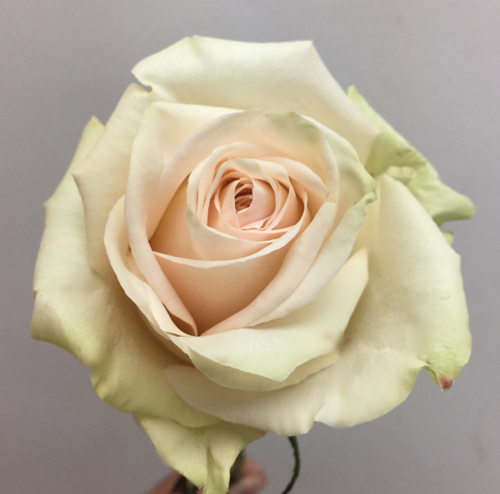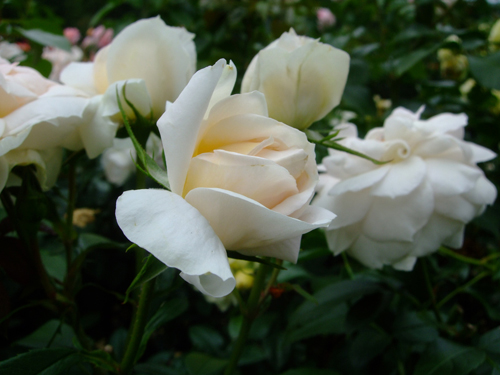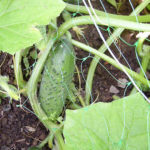Rose La perla (La perla)
Plants with flowers of pastel shades are a symbol of tenderness and sophistication. This is especially true when it comes to roses. Among them there are many varieties that caress the eye with creamy buds. One of the most beautiful representatives of this group is La perla.

History of origin
This variety can be safely called outstanding. La perla is loved by both breeders and ordinary flower growers. The decorative perennial has many awards for its extraordinary attractiveness and enviable endurance. Among them are the first prize of the Vienna Rose Competition, a test certificate (St. Albass, Great Britain) and ADR (Germany), awarded to the plant in 2009. The variety appeared more than 10 years ago in Germany, in the nursery "V. Cordes and Sons", which has thundered all over Europe for a long time. In various sources, you can find other names of the culture: Schloss Gödens Rose, KORpenparo. The name of the delightful flower is translated from Spanish as "pearl".
Description of the variety
La perla is an elegant tea hybrid of not too impressive dimensions (height - about a meter, width - from 30 to 70 cm). Strong, erect shoots of a rose, directed vertically upwards and practically devoid of thorny thorns, are covered with dark green shiny leaves. Against this background, flowers of a light shade look especially impressive. They are large (up to 12 cm in diameter), terry, formed by dense creamy petals, the number of which varies from 35 to 40 pieces in one bud. In cool weather, flowers appear on the bush with sizes slightly exceeding the standard indicators, and the cream petals acquire a greenish color. The aroma of incomparable inflorescences is quite subtle and unobtrusive. The bush begins to bloom in the third decade of June, and this phase ends before the autumn frosts. Each of its shoots bears one bud, however, the formation of several inflorescences on the stem also occurs. The flowering of the variety is abundant, repeated and rather long. The opened buds stay on the bush for a long time: 7-10 days. The first flowering of a shrub may not be as lush as the subsequent ones.
Why is this variety of roses called hardy? For several reasons. Firstly, La perla is very resistant to various kinds of diseases and, above all, to black spot and powdery mildew. Secondly, it is rarely affected by pests. In addition, this La Perla hybrid is characterized by high frost resistance, and its flowers are not afraid of rain.

Features of agricultural technology
The German beauty cannot be called extremely demanding to care for. She, like all tea hybrids, needs regular feeding, watering, weeding. Pruning the plant is important. It is better to moisten the soil under the flower in the early morning or evening. For this procedure, use soft cool water - up to 2 buckets per adult plant. Fertilization is carried out at intervals of 1-2 times a month. Moreover, nitrogen concentrates are used at the beginning of the growing season, and mineral ones - during the formation of buds on the shrub, in the flowering phase and in the fall, two weeks after the disappearance of the inflorescences from the perennial.
To place a rose seedling, sunny places are ideal, where partial shade reigns on a hot afternoon. The soil for the La Perla hybrid needs fertile, light and loose, with a slightly acidic reaction. Too acidic and, even more so, alkaline soil can, if not destroy the plant, then interfere with its normal growth, development and flowering.
Pruning is done in spring and autumn. The spring activity is to remove sick, dead and very weak shoots. The autumn pruning procedure is necessary to prepare the plant for winter, and therefore it consists in shortening all the branches of the shrub without exception. When growing La perla in the middle lane and northern regions, it is worth covering the rose for the period of cold weather. To do this, you can use spruce branches or build a frame over a perennial and tighten it with a film. The main thing is to first spud the plant with earth.
Probable flower diseases: rust and gray rot.Under unfavorable conditions, the culture can be attacked by leaf rollers, aphids, spider mites or caterpillars. For this reason, the perennial needs preventive treatment with insecticides and fungicides, performed several times during the growing season.
Use cases
La perla will certainly become the brightest pearl of your garden, flower garden or rose garden. This rose is planted in flower beds, in mixborders, rabatkas, in borders along garden paths. Ornamental shrubs will look great in a flower garden, laid out in front of the facade of the house and called the parterre. In group compositions, the perennial goes well with bush forms of acacia, privet, sea buckthorn, with magnolia, cotoneaster and conifers. Directly in the mixborders between the plants of the described variety, it is worth placing crocuses, muscaria, snowdrops. A magnificent flower will fit into strict English, classic garden design, as well as a flower garden decorated in a romantic Provence style. The tea hybrid is also used as a cut variety. Its lush buds on strong peduncles, placed in a vase of water, remain attractive for two weeks.








